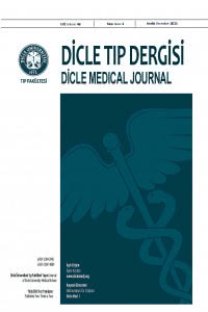The Use Of Fasial Stımilator in Cochlear implant and Fasial Tumor Surgery
Koklear İmplant ve Fasiyal Tümör Cerrahisinde Fasiyal Stimilatör Kullanımı
___
1. Green JD, Shelton C, Brackmann DE. Iatrogenic facial nerve injury during otologic surgery. Laryngoscope. 1994; 104: 922-6.2. Marina MB, Mazita A, Fadzilah I, et al. Iatrogenic facial nerve palsy: lessons to learn. Singapore Med J. 2009; 50: 1154-7.
3. Silverstein H. Adaptor for continuos Stimulation (SACS) with the WR-S8 monitor stimulator. Otolaryngol Head Neck Surg. 1990; 103: 493-6.
4. Schuring AG. Iatrogenic facial nerve injury. Am J Otol. 1988; 9: 432-3.
5. Nilssen EL, Wormald PJ. Facial nerve palsy in mastoid surgery. J Laryngol Otol. 1997; 111: 113-6.
6. Selesnick SH, Lynn-Macrae AG. The incidence of facial nerve dehiscence at surgery for cholesteatoma. Otol Neurotol. 2001; 22: 129-32.
7. Wang H-M, Lin J-C, Lee K-W, et al. Analysis of mastoid findings at surgery to treat middle ear cholesteatoma. Arch Otolaryngol Head Neck Surg. 2006; 132: 1307-10.
8. Delgado TE, Bucheit WA, Rosenholtz HR, et al. Intraoperative monitoring of facila muscle evoked responses obtained by intracranial stimulation of the facila nerve: a more accurate technique for facila nerve dissection. Neurosurgery. 1979; 4: 418-21.
9. Roland PS, Meyerhoff WL. Intraoperative electrophysiological monitoring of the facial nerve: Is it standard of practice? Am J Otolaryngol. 1994; 15: 267- 70.
10. Prass RL. Iatrogenic facial nerve injury: the role of facial nerve monitoring. Otolaryngol Clin North Am. 1996; 29: 265-75.
11. Dr. Nuri Özgirgin, Dr. Tuncay Özçelik, Dr. Selçuk Aksoy, Dr. Barkın Gürcan. Fasiyal sinir monitorizasyonu. K.B.B. ve Baş Boyun Cerrahisi Dergisi.1993; l: 205-8.
12. Silverstein H., Smouha EE., Jones R. Routine intraoperative facial nerve monitoring during otologic surgery. The American Journal of Otology.1988; 9: 269- 75.
13. Leonetti JP, Matz GJ, Smith PG. Facial nerve monitoring in otologic surgery: clinical indications and intraoperative technique. Ann Otol Rhinol Laryngol. 1990; 99: 911-8.
14. Guntinas-Lichius O, Eisele DW. Facial Nerve Monitoring. Adv Otorhinolaryngol. 2016; 78: 46-52.
15. Babin RW, Ryu JH, McCabe BF. Responses to step and repeated impulse accelerations in second order vestibular neurons of the cat. Am J Otolaryngol. 1980; 1: 385-923.
16. Boublata L, Belahreche M, Ouchtati R, et al. Int Vestibular Schwannomas Surgery Operated By Retrosigmoid Transmeatal Approach in Semi-sitting Position with Intraoperative Facial Nerve Monitoring. World Neurosurg. 2017; 103: 231-40.
17. Yingling CD, Gardi JN. Intraoperative monitoring of facial and cochlear nerves during acoustic neuroma surgery. 1992. Neurosurg Clin N Am. 2008; 19: 289- 315.
18. Chen L, Chen L, Liu L, et al. Vestibular schwannoma microsurgery with special reference to facial nerve preservation. Clin Neurol Neurosurg. 2009; 111: 47-53.
19. Yingling CD, Gardi JN. Intraoperative monitoring of facial and cochlear nerves during acoustic neuroma surgery. 1992. Neurosurg Clin N Am. 2008; 19: 289- 315.
20. Kassam S Chegini S,M Kumar. Pitfalls in monitoring of the facial nerve during operations for parotid cancer. British Journal of Oral and Maxillofacial Surgery.2017; 55: 863–4.
- ISSN: 1300-2945
- Yayın Aralığı: 4
- Başlangıç: 1963
- Yayıncı: Cahfer GÜLOĞLU
Investigation of Pepsin in Laryngeal Squamous Cell Carcinoma Specimens
Hamdi TAŞLI, Burcu ESER, Hakan BİRKENT, Burak AŞIK, Mustafa GEREK
Akut ve Kronik Pulmoner Tromboembolide Cerrahi Tecrübelerimiz
Mehmet IŞIK, Ömer TANYELİ, Yüksel DERELİ, Erdal EGE, Niyazi GÖRMÜŞ
The Use Of Fasial Stımilator in Cochlear implant and Fasial Tumor Surgery
MEHMET AKDAĞ, Ediz Argün YORGANCILAR, Müzeyyen YILDIRIM BAYLAN
DİLER US ALTAY, Özlem ÖZDEMİR, TEVFİK NOYAN, Sefa YÜKSEL, Burhanettin Sertaç AYHAN
Muhammed Cihan TEMEL, Serkan AKAN, Caner Ediz, Neslihan KAYA TERZİ, Ömer YILMAZ
